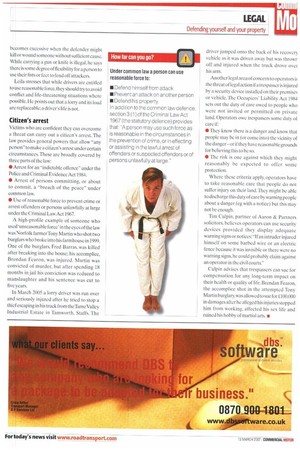Stand your ground within reason
Page 36

Page 37

If you've noticed an error in this article please click here to report it so we can fix it.
Dperators need to be wary of the law when defending themselves against thieves and
attackers. Andy Moore explains why...
Defending yourself, your vehicle and your property has never been more mportant as high levels of crime hit the UK's road freight industry. According to the Road Haulage Association there are more than 40,000 truck crimes a year, with about 3,0(X) vehicles stolen that are never recovered. The ;ector is fraught with cases of hijackers and thieves using force to overpower drivers.
Last February, in the UK's biggest ever robbery, gunmen stole £50m from a Securitas depot in Kent.The gang tied up 15 members of staff before making off with the cash .They took the depot manager's wife and son as hostages, forcing the manager to let them into the highsecurity compound.
But how far can operators and drivers legally defend their bases and trucks from attackers? The concept of defence exists both at common law and by statute (see panel).But while victims are entitled to defend themselves, the term "reasonable force" is open to interpretation.
Simon Leila is managing director of 360 Defence, which specialises in training for counter terrorism, self-defence and 'asset protection'. He believes that "reasonable force" can be defined as taking physical action in moderation:"Drivers are legally allowed to use pre-emptive strikes if they are in fear of their life or being injured. If someone is pulling a gun on you. you don't wait to be shot."
He adds that if someone has good reason to believe an attacker is carrying a knife or a gun, he can legally use a pre-emptive strike even if he doesn't actually see the weapon: "There is a fine line when using self-defence to protect yourself — don't go over the top by making repeated attacks, causing injury or even death. However, if an individual has substantial reason to believe that he will be killed, he is legally within his rights to use deadly force."
Leila explains that reasonable force becomes excessive when the defender might kill or wound someone without sufficient cause. While carrying a gun or knife is illegal, he says there is some degree of flexibility for a person to use their fists or feet to fend off attackers.
Leila stresses that while drivers are entitled to use reasonable force, they should try to avoid conflict and life-threatening situations where possible. He points out that a lorry and its load are replaceable; a driver's life is not.
Citizen's arrest
Victims who are confident they can overcome a threat can carry out a citizen's arrest. The law provides general powers that allow "any personto make a citizen's arrest under certain circumstances. These are broadly covered by three parts of the law: • Arrest for an "indictable offence" under the Police and Criminal Evidence Act 1984.
• Arrest of persons committing, or about to commit, a "breach of the peaceunder common law.
• Use of reasonable force to prevent crime or arrest offenders or persons unlawfully at large under the Criminal Law Act 1967.
A high-profile example of someone who used 'unreasonable force' in the eyes of the law was Norfolk farmer Tony Martin who shot two burglars who broke into his farmhouse in 1999. One of the burglars, Fred Barras, was killed after breaking into the house; his accomplice, Brendan Fe aron, was injured. Martin was convicted of murder, but after spending 18 months in jail his conviction was reduced to manslaughter and his sentence was cut to five years.
In March 2005 a lorry driver was run over and seriously injured after he tried to stop a thief escaping in his truck from the Tame Valley Industrial Estate in Tamworth, Staffs. The driver jumped onto the back of his recover vehicle as it was driven away but was throwr off and injured when the truck drove ovei his arm.
Another legal area of concern to operators the threat of legal action if a trespasser is injured by a security device installed on their premises or vehicle. The Occupiers' Liability Act 1984 sets out the duty of care owed to people who were not invited or permitted on private land. Operators owe trespassers some duty of care if: • They know there is a danger and know that people may be in (or come into) the vicinity of the danger —or if they have reasonable grounds for believing this to be so.
• The risk is one against which they might reasonably be expected to offer some protection.
Where these criteria apply, operators have to take reasonable care that people do not suffer injury on their land. They might be able to discharge this duty of care by warning people about a danger (eg with a notice) but this may not be enough.
Tim Culpin, partner of Aaron & Partners solicitors, believes operators can use security devices provided they display adequate warning signs or notices: "If an intruder injured himself on some barbed wire or an electric fence because it was invisible or there were no warning signs, he could probably claim against an operator in the civil courts."
Culpin advises that trespassers can sue for compensation for any long-term impact on their health or quality of life. Brendan Fearon, the accomplice shot in the attempted Tony Martin burglary. was allowed to sue for £100,000 in damages after he alleged his injuries stopped him from working, affected his sex life and ruined his hobby of martial arts. •


























































































































































































